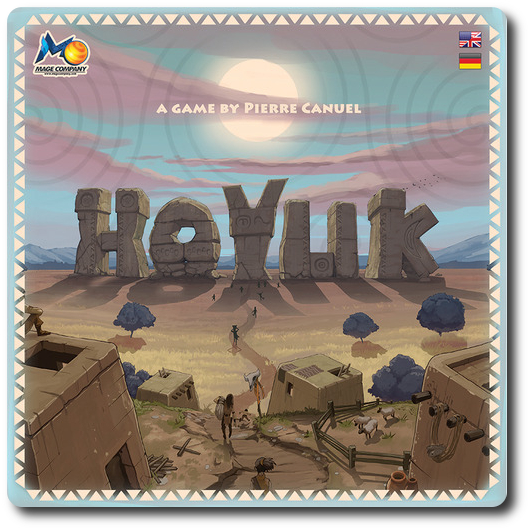
The Basics:
- For ages 7 and up (publisher suggests 10+)
- For 2 to 5 players
- Approximately 60 minutes to complete
Geek Skills:
- Counting & Math
- Logical & Critical Decision Making
- Pattern/Color Matching
- Strategy & Tactics
- Hand/Resource Management
- Worker Placement & Area Control
Learning Curve:
- Child – Easy (if playing Basic game)
- Adult – Easy
Theme & Narrative:
- Lead your clan and dominate the valley!
Endorsements:
- Gamer Geek approved!
- Parent Geek approved!
- Child Geek approved!
Overview
The peaceful valley where 5 tribes have sheltered for generations, harvested crops, bred animals, and raised children has a problem. It’s over populated. Land is scarce, but not ambition. Each clan pushes to occupy more and more land to further their own goals, which causes other clans to have less to work with. The pursuit of peaceful coexistence has been replaced by each clans’ ambition for personal power. You must now lead your clan to victory or the valley may no longer be your home!
Hoyuk (also typed as “Höyük“, in some cases), designed by Pierre Canuel and published by MAGE Company, is comprised of 1 game board, 125 House tiles (5 different colors, 25 per color), 40 Pen tiles, 20 Oven meeples, 20 Shrine meeples, 1 Shaman meeple, 20 Villager meeples, 20 Cattle meeples, 5 Player counters, 1 Player marker, 24 Catastrophe cards, 70 Aspect cards, and 15 Construction tiles. The game component quality is excellent. Each tile is made of thick and very durable cardboard and the meeples and counters are made of wood.
Game Set Up
Note: There are three ways to play Hoyuk: Basic, Medium, and Advanced. The Basic game play is described here. Medium and Advanced game play is summarized in the “Game Variants” section below.
To set up the game, first place the game board in the middle of the playing area. The game board is pretty big, meaning you’ll need a medium to large-sized table to fit all the game components and players. The game board also only uses symbols. That can be confusing for new players, but reduces the need to read in order play the game. Use the following image as a guide.

A) These spots are reserved for the Advanced game Aspects. From top to bottom: Cattle and Villagers. The Shaman meeple will also be used in the Advanced game and is placed next to the Catastrophe cards (D).
B) These spots are reserved for the Medium game Aspects. From top to bottom: Height of Houses and Number of Houses.
C) These spots are reserved for the Basic game Aspects. From top to bottom: Pens, Shrines, and Ovens.
D) These two spots are reserved for the Catastrophe cards (the area with the lightening bolt symbol) and the Construction tiles (the area with a house symbol).
E) This spot is reserved for the Shrine meeples.
F) This spot is reserved for the Oven meeples.
G) This spot is reserved for the Cattle meeples when they are used.
H) This spot is reserved for Villager meeples when they are used.
I) This spot is reserved for the Pen tiles.
J) The Score track records the players’ points as the game progresses. It also serves as a boarder for the tile placement area.
K) The area in which all the tiles will be placed. Tiles can be placed over rocks, trees, water, and that adorable family of deer. Tiles cannot be placed on or over the Score track.
Second, have each player select a Player counter and place it on the “0” space on the Score track (J). Each player should now collect all 25 of their House tiles that match the color of their Player counter. Any Player counters or House tiles not used should be returned to the game box.
Third, take the Catastrophe cards and remove 2 “Earthquake”, 2 “Tornado”, 2 “Bad Season”, 2 “Sacrifice”, 2 “Locust Swarm”, and 2 “Fire” Catastrophe cards for a total of 12 cards. Place the remaining Catastrophe cards back in the game box. Shuffle the selected Catastrophe cards and place them face-down on the Catastrophe space on the game board (D).
Fourth, take the Shrine meeples, Oven meeples, and Pen tiles and place them on their matching spaces found on the game board (E, F, and I). The Cattle and Villager meeples are not used in the Basic game and can be returned to the game box.
Fifth, take the Aspect cards and remove the cards that depict the Shrine, Oven, and Pen. A small icon depicting each is found at the top-left corner on the card’s face.In addition, remove 3 “Wild” Aspect cards and 6 “House” Aspect cards. You should now have a total of 30 Aspect cards. Shuffle these cards and deal 10 to the “Pen”, “Shrine” and “Oven” Aspect spaces on the game board (C), face-up. Return unused cards back to the game box.
Fourth, take the Construction tiles and remove 5 specific tiles. The game is language-independent, which means two things. First, any player from any part of the world can play it because everything is icon or symbol based. Second, I cannot tell you what specific tiles to remove. The rule book displays an image of the Construction tiles that should be taken out and placed back in the game box. This will leave you with 10 Construction tiles which should now be shuffled and placed face-down in the space directly below the Catastrophe cards (D).
Fifth, take 2 House tiles from each player, shuffle them, and then reveal 1. The player who owns that House tile takes the Marker tile and is the first player for the first round. Return all House tiles to their owners.
That’s it for game set up. Let’s begin.
A Look at the Aspects
Aspect cards are collected during the 3rd phase of a round and can be played at the START of any of the 4 phases in a round after they have been won. Aspect cards can be used to build more elements (explained in “Phase 1: Construction”) or used to score points.
At the start of each phase, every player in turn order sequence has an opportunity to play 1 or more Aspect cards from their hand. Or, if the player prefers, they can simply pass. The number of Aspect cards the player can play is determined by the total number of families the player has. Since the total number of families can change during different phases, and most certainly rounds, the player should first do a quick count to make certain they know how many cards they can play in the round. Played Aspect cards are left in front of the player, face-up, to help remind the player how many total Aspect cards they have played so far. As long as the total number of Aspect cards played during the round is less than the total number of families the player has in that particular phase, the player can play 1 or more Aspect cards as long as the total number of Aspects cards does not exceed the current total family count.
Building Additional Elements or Grouping for Points
An Aspect card that has the symbol of one of the elements can be used to build that element. This can be done even if it isn’t the first phase, allowing the player to build to the game board when other players cannot. The rules for placement of tiles and meeples does not change, however.
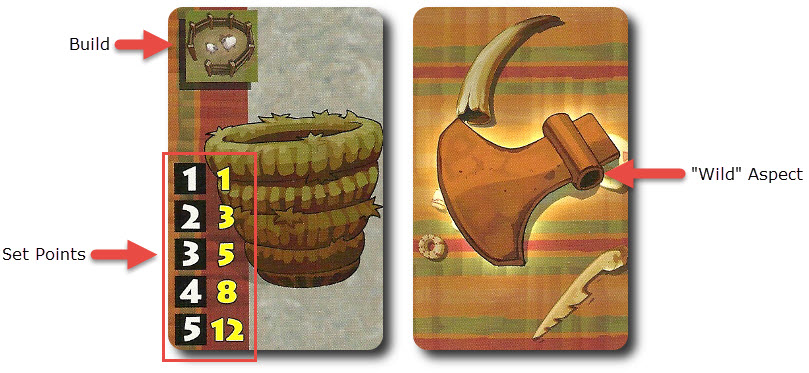
An Aspect card can also be collected and played as a set with 1 or more Aspect cards that have the same element symbol (the above example shows a Pen symbol). The more cards in the set, the more points the player can earn. However, the total number of Aspect cards the player can play during the round and phase is always determined by the number of families they have. The “Wild” Aspect cards can be used to represent any element icon. Any points scored by the player are recorded on the Score track on the game board.
Once Upon Over 10,2015 Years Ago…
Hoyuk is played in rounds with no set number of rounds per game. Each round is divided into 4 phases. Each phase is summarized here. The game’s rule book goes into great detail about how each phase is played and provides many visual examples. As I dislike reinventing the wheel, I will highlight the focus of each game phase in order to provide a general idea of the game play. I encourage you to review the game’s rule book for more details.
Phase 1: Construction
The first phase of every round is dedicated to building. Starting with the current first player and continuing in turn order sequence, each player is given 1 Construction tile which is placed face-up in front of them. The Construction tile identifies 3 different things that can be built, referred to in the game as “elements”. These elements will depict the House, Shrine, Pen, and Oven. Some Construction tiles will show four or fewer small images clustered together. These indicate that the player may choose 1 of the elements depicted.
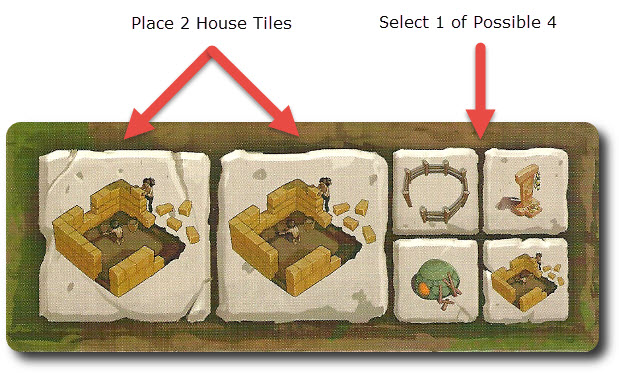
Again, in turn order sequence, each player collects the elements shown on their Construction tile and places them on the game board. The game board is organized like a grid. This grid helps the players place their tiles and keep everything organized. The surrounding Score track acts as a border that tiles cannot be built on or over.
After all players have complete their first Construction tile, they are discarded. A second Construction tile is then drawn by every player. The process is now repeated in turn order sequence. In the event that there are not enough Construction tiles to draw, shuffle the discarded Construction tiles and place them face-down to create a new draw pile.
Each tile has placement rules. For the Basic game, the tiles used and their build rules are summarized here:
Houses
When building with House tiles, there are two important terms players should know.
- A “family” is made of adjacent House tiles of the same color.
- A “block” is made of adjacent houses, pens, and rubble that can be of any color.
The House tile can be built on any open space on the game board, with only a few restrictions applying. If placed alone, it’s referred to as a”block”. Two or more House tile adjacent to each (not diagonal) are referred to as a “family” if they are the same color. Creating families is important for 2 reasons. First, it allows the player to start dominating more space on the game board making it easier to play tiles. Second, families protect the player to a small extent from the penalties caused by Disasters and allow the family to continue to grow when parts of it are reduced to ruins. Ruined Houses are flipped over and occupy the space on which the House used to be built. These spaces are considered to be “neutral” and can be built on top of (replacing the rubble tile in the process).
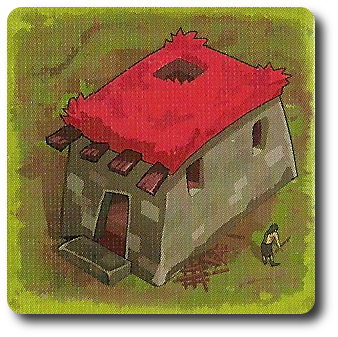
Additionally, players cannot bridge two different blocks or families belonging to different players. The space that divides them cannot be built to. It’s possible that there will come a point where players cannot build to the game board. In which case, the game ends.
Players can also build a second story by stacking House tiles, but doing so counts as one of their 3 builds. Players can only build on top of their own House tiles and only if that House tile has one of its adjacent sides open. If they build on a single story House tile that contains an Oven or a Shrine meeple, they must return the meeple to its supply before the House tile is placed. Building a second story to a house helps with tie breakers and can mean the differences between victory and defeat. However, and I cannot stress this enough, players only get to build 3 times per Construction tile. If the player chooses to build a second story on their house, they must ignore one of the elements shown on the Construction card. Essentially, it’s one or the other. For example, a player could build 2 of the elements shown on the Construction card (their choice) and ignore the third to build a second story to a house.
Pens
The Pen tiles are places so they are adjacent to House tiles. A single House tile could have as many as 4 Pen tiles surrounding it. It’s worth noting that Pens connect House tiles and can be used to create larger blocks. However, a Pen tile must always have 1 of its 4 sides adjacent to an empty space on the game board. This is another way to block opponents from building, but it can cause a player problems if they don’t properly place their Pen tile when building it themselves. The white arrow points to the adjacent space that must be kept clear.

Shrine and Oven Meeples
The Shrine and Oven meeples are placed on previously placed House tiles. A House can have a Shrine or an Oven meeple; not both. A House with a Pen tile adjacent to it can be given a Shrine or Oven meeple. A House with a second story can also be given a Shrine or Oven meeple.
Phase 2: Catastrophe Strikes!
If this is the first round of the game, this phase is skipped. All subsequent rounds get pummeled.
The first player now draws 1 Catastrophe block and announces what it does. Each Catastrophe card will identify what element is effected and how. The element identified could be a single block or larger blocks. The effect could be turning over the identified element tile or removing it from the game board. Some are also conditional. For example, the “Bad Season” Catastrophe card calls for the player with the fewest Shrine meeples to flip over 1 of their House tiles.
Let’s take a look at two other examples.
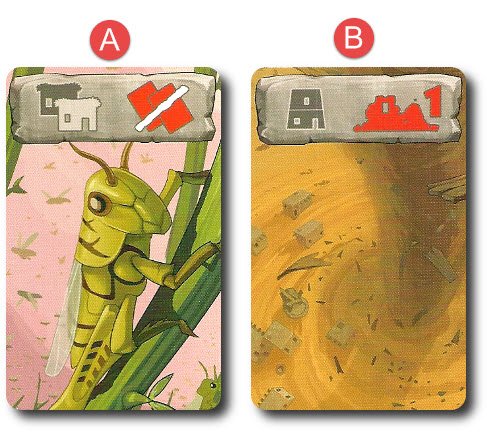
A) “Locust Swarm”: The largest block of House tiles this round is unable to earn any Aspect cards.
B): “Tornado”: The block with the fewest second story House tiles forces each player who has a House tile in that block to turn it to rubble.
If the icons don’t make any sense to you, the rule book provides a quick summary of each action.
Each player will resolve the Catastrophe card for their own blocks where applicable. Players should pause and consider what they are removing or flipping over to rubble. Removing the wrong tile could open a path for opponents. Then again, players might be able to make “lemonade from lemons”. It’s possible that a demolished building opens the door for a better building opportunity and points.
Phase 3: Aspects
The game board is now inspected to determine which players have the most of the aspects currently in play. For the Basic game, these will be Oven, Shrine, and Pens. Houses are not considered aspects. The player who has the most of a specific aspect draws the matching top-most Aspect card. If there are no more cards for the Aspect being counted, the winner doesn’t get any cards, which makes the other players feel pretty good.
One at a time and for each block, the aspects are counted. The first player determines which aspect will be counted first, followed by the second player in turn order sequence selecting the second aspect, and so on. Players should not take this part of the exercise lightly as it’s possible to quickly run out of Aspect cards. Ties for total number of aspects in a block are broken by counting the House tiles that have a second story. If there is still a tie, or no second stories are built, the tied players receive nothing.
One final and very important point to make when inspecting blocks. A block that consists only of 1 player’s tiles is ignored. A block must contain 2 or more player tiles to be counted during this phase.
Phase 4: Ending the Round
The round is now over. Any Aspect cards the player used during the round are collected, shuffled, and placed back on any Aspect card space on the game board. This is done in turn order sequence starting with the first player. If there are cards already present, the player’s cards are placed underneath. Empty card spaces can be filled this way, but it might not always be in a player’s best interest to put one of their played Aspect cards there. There is no limit to how many Aspect cards can be contained in any Aspect card space during the game.
After all the players have placed their used Aspect cards, the first player hands the Marker tile to any other player of their choice, making the selected player the first player for the next round. The first player for the current round cannot be the first player for the next round.
Ending the Game
The endgame is triggered when a player has placed all 25 of their House tiles or players are unable to legally place any of their tiles during Phase 1: Construction. The current round is completed, allowing players one last opportunity to score points.
Points are now counted and recorded on the Score track as follows. These are added to the points the players earned during the game.. I suggest you go about doing this in turn order sequence where applicable.
- For every Aspect card not played, score 1 point
- The player with the largest family of each block (highest number of adjacent House tiles regardless of height) scores 1 point per House tile
The player with the most points wins the game.
Game Variants
Shorter Games
A normal game uses 25 House tiles. For a shorter game, reduce the total number of House tiles. For example, 15 House tiles per player.
Medium Game Play
The Medium game play is played exactly like the Basic game, but introduces 2 new Aspects. These are Number of Houses and Height of Houses. Players now have a chance to collect more Aspect cards based on the number of House tiles in play and the total height of their House tiles.
Advanced Game Play
The Advanced game is played exactly like the Medium game, but introduces Cattle, Villagers, and the Shaman meeple. Long story short, these add more ways for players to collect Aspect cards and points. Building becomes all the more difficult due to the new elements. Of course, this also means that the Advanced game demands a higher level of strategic and tactical game play from all of its players.
Clan Powers
The five different colors used for scoring and House tiles represent 5 different clans. This game variant gives each clan a special power that can be used only when the player has 5 Aspect cards and scores 12 points for the set. The power is then triggered (if the player wants to) and can be triggered again whenever the player scores 12 points with an Aspect set.
Powers include destroying House tiles, collecting a free Pen tile and Cattle meeple that can be placed immediately, collecting 1 Pen tile and 1 Villager meeple that can be placed immediately, steal 2 elements (other than House tiles) from any opponent, and building 1 House tile that the Shaman meeple immediately moves into.
To learn more about Hoyuk, visit the game’s web page.
Final Word
To be perfectly clear, we only played the Basic game with the Child Geeks. Early testing suggested that the Medium and Advanced games would be too much for our younger and less experienced players. We also reduced the total number of House tiles to keep the games to no more than about 30 minutes. It’s important to note that these changes were suggested by the game designer, so we are technically still playing the game as designed. That being said, all the Child Geeks really enjoyed themselves. According to one Child Geek, “Check this out! If I can build just one more Shrine, I’m going to have enough Aspect cards for some major points! I love this game!” Another Child Geek said, “I think this game is hard sometimes and easy other times. I hate the Catastrophes.” He was not alone in his dislike of the Catastrophe cards. Despite this Child Geek’s grumbling over natural disasters, all the Child Geeks voted to approve Hoyuk, finding it to be an intuitive and entertaining tile game.
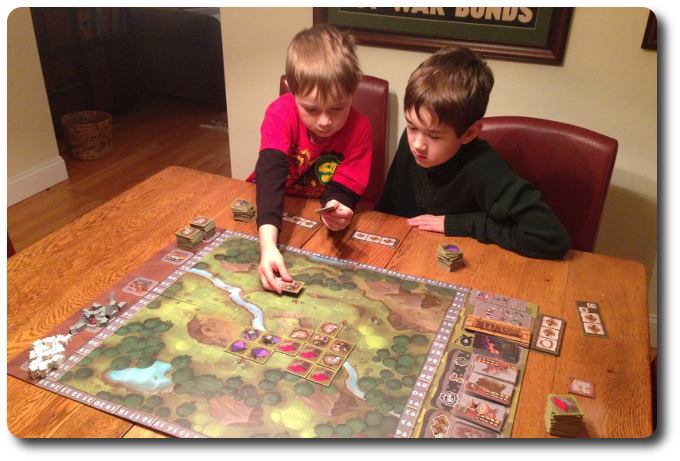
Older brother teaches the game to his younger brother. His younger brother wins. Hilarity ensues.
The Parent Geeks also really enjoyed the game. We started at Basic and ended up always playing using the Medium game rules. For larger groups of players, we reduced the total number of House tiles in play to ensure there would be just enough building room, but never to a point where spaces were wide open. This reduced the game’s length for the larger games and allowed player to quickly resolve their turns. According to one Parent Geek, “I like this. The fact that I can adjust the difficult of the game easily, but reduce none of the fun is important. This also allows me to make this a family game, an adult game, or a gamer’s game with my gaming friends.” Yes, it certainly can! Another Parent Geek said, “At first, I was all like, where’s the challenge here? Then, after a couple of rounds, I was all like, oh, damn, now this is starting to get hard! The game really sneaks up on you if you don’t watch it.” That quote was surprisingly hard to write. What was not difficult was capturing the Parent Geek’s enjoyment while playing Hoyuk. When all the Houses were built, cattle penned, and ovens lit, the Parent Geeks voted to approve Hoyuk.
We jumped right to the Advanced game with the Gamer Geeks which proved to be the right course of action. The Gamer Geeks immediately understood how to play the game and got to work. I always find it fascinating to watch the same game played by different groups of people. The way the Gamer Geeks observed the board and their opponents was very different from our other groups. Every tile played had a purpose, every Aspect card was part of a plan, and every Catastrophe card drawn resulted in swearing. Turns out that the Gamer Geeks are the biggest whiners in the world when it comes to random displacement of tiles. According to one Gamer Geek, “If it weren’t for those damn Catastrophe cards I’d say this was the perfect game.” Another Gamer Geek said, “The Catastrophe cards feel like an unnecessary element in an otherwise interesting game.” However, none of the Gamer Geeks felt that the Catastrophe cards broke the game. They merely disrupted strategies and tactics, which the Gamer Geeks begrudgingly agreed was a pretty good way of keeping players on their toes. As one Gamer Geek put it, “Sometimes a game has to push you to keep you from finding your balance, but it never pushes you off the ledge.” When all the games were over, the Gamer Geeks agreed that they had fun, were challenged, and that Hoyuk was a game they enjoyed.
I like everything about this game except the catastrophes, but I understand why they are there. They are meant to shake things up, keep the game board changing, and force players to think wisely about what they are building and where. I can’t help but consider that I would prefer the game play if the catastrophes were missing, but I can’t imagine the game without them. It’s a conundrum. This is one of those cases where one small thing nags you, but doesn’t stop you from enjoying yourself. It’s like the mosquito that bites you on the hike. It didn’t ruin your day, but it left you feeling a bit itchy and irritated.
I’m from Minnesota, so everything is about mosquitoes. That and hotdishes.
Lots of interesting things going on in Hoyuk. Depending on what type of game you are playing (Basic, Medium, or Advanced), there are different ways to score points. I personally found the Advanced game to be the most challenging, but the Basic game is the most entertaining. The Basic game is lighter, but feels more streamlined and focuses more on building with a small set of tiles. In contrast, the Advanced game is all about layering. The difference between the two game versions is like night and day when it comes to the level of strategy and tactics used. The Medium game sits comfortably between the two, providing players an opportunity to explore the game a bit deeper without kicking them headfirst into the deep end of the pool.
In a way, the game designer has provided its players an opportunity to learn, play, and explore the game in a very natural way. Starting at Basic introduces the core concepts and scoring. The Medium game introduces new decisions to be made and strategies to consider. The Advanced game introduces additional strategies and tactics, further reinforcing the concepts in the Basic and Medium game. Or, if you prefer, crawl, walk, and run.
A big surprise for me was how much fun I had with the Aspect cards. Using them to build or set collect for points is a fun game mechanic. Throw in a limit to how many cards you can play based on tiles, and you have yourself a multilevel puzzle to sort out. Do I spend all the cards now for victory points or wait in hopes of having a larger family? Or should I spend one of my cards now to build and grab that open spot caused from the Catastrophe card? What makes this even worse and fun at the same time is that players get to ask the same question at the start of every round. The game always gives you an opportunity to do “something”, but never makes it obvious.
Tile playing games are not for everyone, but Hoyuk seemed to make everyone happy. Certain aspects of the game made our players roll their eyes, grit their teeth, or clench their jaw, but everyone left the table feeling satisfied. From Child Geek to gaming elitist, Hoyuk challenged and entertained in equal measure. If this game sounds like something you and yours would enjoy, give it a go.
This game was given to Father Geek as a review copy. Father Geek was not paid, bribed, wined, dined, or threatened in vain hopes of influencing this review. Such is the statuesque and legendary integrity of Father Geek.




Great review! Thanks for putting this game on my radar. I always love games that are specifically designed for different player levels and desired experiences. This one seems to do that quite nicely. I certainly do plan on giving it a go now!
Have a great day!
Cheers,
David
Thanks for reading the review and leaving a comment, David.
Hoyuk can easily be modified to fit the needs of different groups and skill levels. Each game mode adds another level of complexity and depth. I suggest you start all your players with the Basic game play and go from there. Even the “easiest” game is not that easy, but it does a great job of introducing the game play in a manner that can be quickly be taught and is fun to play.